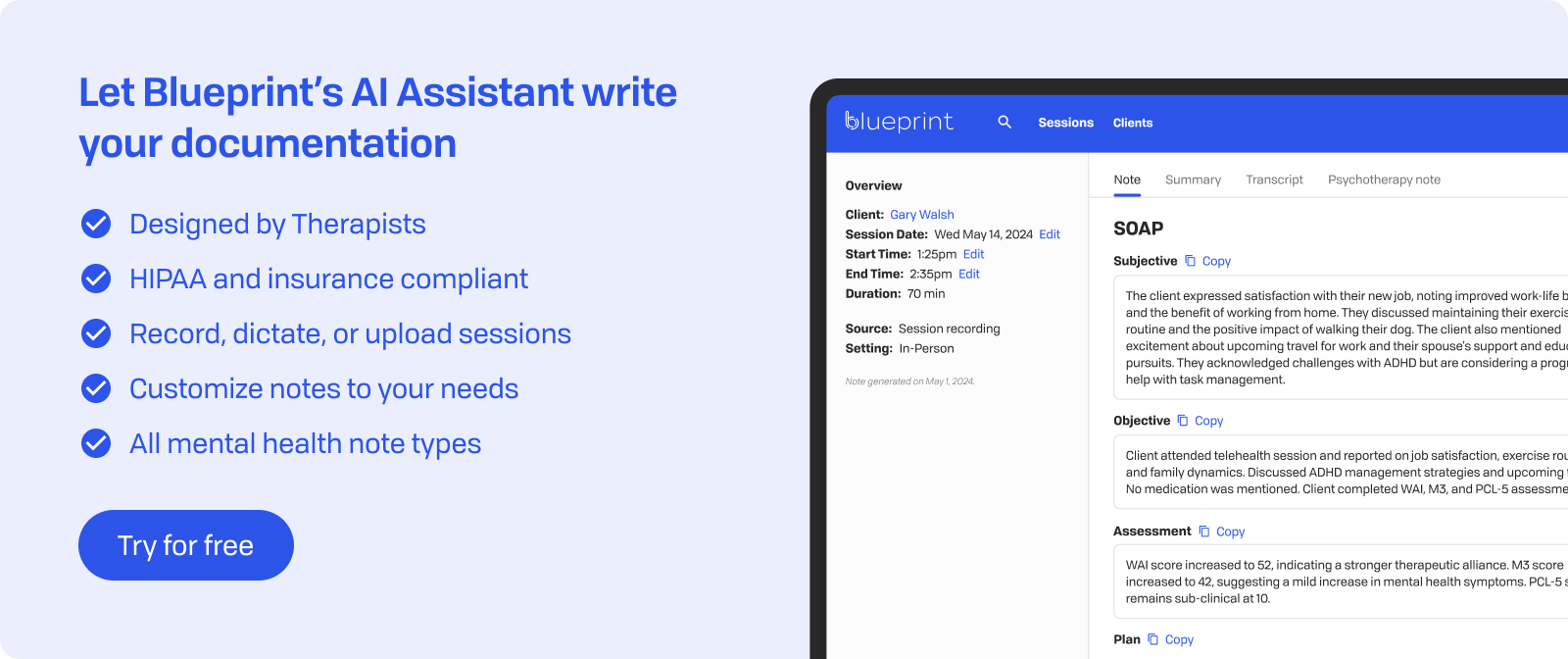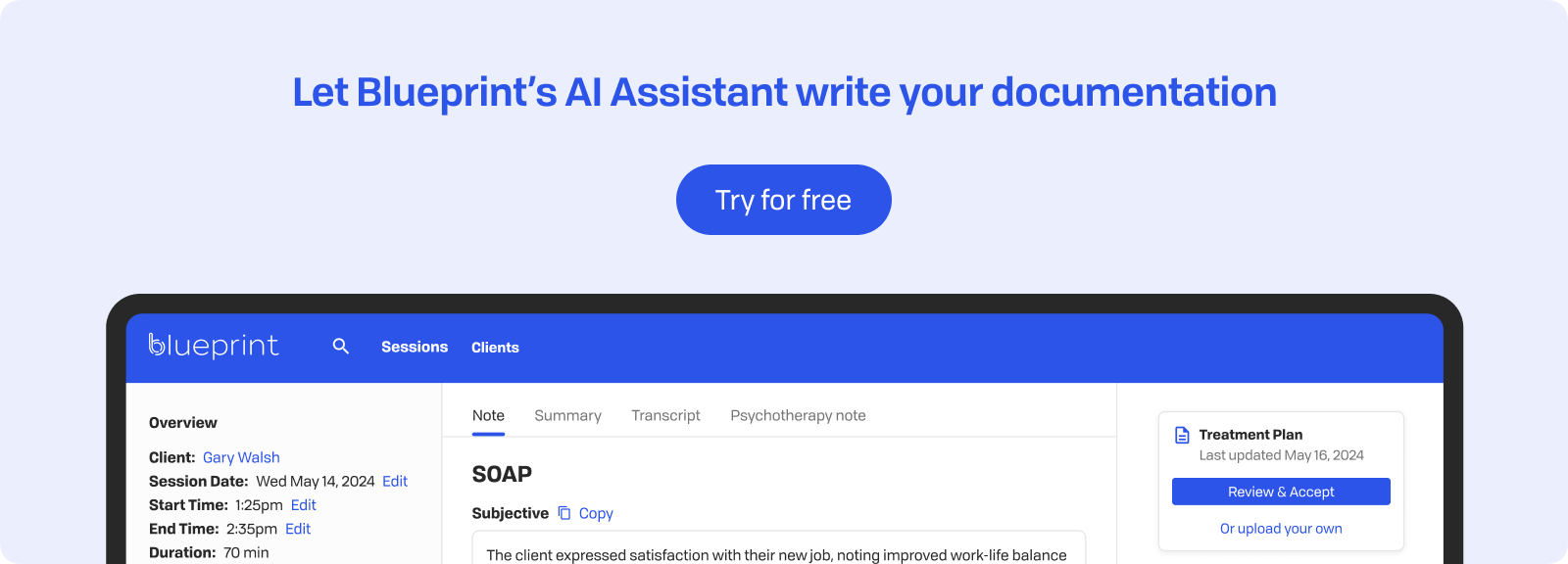
In Brief
If you've navigated the world of mental health training, you know the first years of being a therapist is a crucial period that shapes every clinician's journey. This phase connects academic preparation with independent practice.
The path from graduate school to full licensure includes multiple stages, each with specific requirements, responsibilities, and professional boundaries. Grasping these details directly influences supervision quality, client care, and career direction.
Let's look at what it means to be in this important stage of professional development. We'll examine the educational pathway, scope of practice, supervision dynamics, common challenges, and opportunities that define this period in a therapist's career.
The Role of a Pre-Licensed Therapist
A pre-licensed therapist completes their graduate education but hasn't yet met all requirements for independent licensure. This designation typically applies to those who have earned a master's or doctoral degree and are accumulating supervised clinical hours. They are no longer students but aren't yet autonomous practitioners.
This stage stands between student practicums and full licensure in the clinical training pipeline. While student interns are still completing their degree requirements, pre-licensed therapists have graduated and work under supervision as provisional professionals. They carry more responsibility than student interns but require oversight that fully licensed clinicians don't need.
The pre-licensed period varies by state and discipline, typically lasting 2-4 years post-graduation. During this time, therapists must complete between 1,500-4,000 supervised clinical hours, depending on their license type and jurisdiction. They work under titles like "registered intern," "associate," or "resident," with specific designations varying by state regulations.
Understanding this role benefits everyone in the clinical ecosystem. Supervisors can provide appropriate oversight and continue the clinical training progress, knowing their supervisors have foundational skills but need guidance on areas particular to that therapist’s areas of growth, such as working with complex cases, exploring countertransference or parsing out nuances that are present in clinical presentations. Referral sources can make informed decisions about client placement, recognizing that pre-licensed therapists can offer quality care with built-in consultation.
For the therapists themselves, clarity about their professional status helps set realistic expectations. They can confidently explain their qualifications to clients while acknowledging their supervised status. This transparency builds trust and helps clients understand the additional layer of clinical support their treatment receives.

Educational Pathway and Preparing for Supervision
Starting the journey to become a pre-licensed therapist involves completing a master's or doctoral degree in fields like counseling, clinical psychology, social work, or marriage and family therapy. These programs generally require 48-60 credit hours, covering core subjects such as human development, psychopathology, research methods, ethics, and multicultural counseling.
Academic programs stress the importance of practical experience through practicum and internship opportunities. Students complete 600-1,000 hours of supervised clinical work, where they develop essential skills in:
- Assessment and diagnosis: Conducting clinical interviews, using screening tools, and formulating diagnostic impressions
- Rapport-building: Practicing therapeutic presence, active listening, and creating safe therapeutic spaces
- Ethical decision-making: Applying professional codes of ethics to real-world clinical scenarios
- Case conceptualization: Integrating theory with client presentations to develop treatment approaches
Proactive pre-licensed therapists align their academic training with state licensure requirements early on. Research your state's specific supervision requirements during your program—some states require supervisors to hold certain credentials or complete supervision training. Knowing these requirements helps you choose practicum sites and supervisors who meet regulatory standards.
Preparation for post-graduation supervision begins during your academic program. Keep detailed records of your clinical hours, maintain organized case notes, and develop a habit of reflective practice. Set up systems for tracking client hours and treatment outcomes that you can continue to use during your pre-licensed period. This groundwork ensures you're ready to make the most of supervision opportunities and move efficiently toward independent practice.
Scope of Practice and Ethical Boundaries
Pre-licensed therapists work within specific professional guidelines that protect both clients and the integrity of the therapeutic process. Knowing these boundaries allows you to practice confidently while maintaining appropriate oversight.
What pre-licensed therapists can do:
- Direct client work: Conduct individual, group, and family therapy sessions under supervision
- Clinical documentation: Write progress notes, treatment summaries, and discharge reports
- Treatment planning: Develop and implement treatment plans with supervisor guidance
- Assessment activities: Conduct intake interviews and write biopsychosocial assessments
- Crisis intervention: Provide immediate support with supervisor consultation available
What requires supervisor involvement:
- Formal diagnoses: Depending on the jurisdiction of licensure, diagnostic decisions may need to be reviewed and co-signed by a licensed supervisor
- Treatment plan signatures: Plans require supervisor approval before implementation
- Independent practice: Cannot see clients without an established supervision agreement
- Termination decisions: Major treatment changes include supervisor consultation
Ethical practice during this phase involves maintaining clear professional boundaries while acknowledging your training status. Key considerations include:
- Transparency with clients: Clearly explain your supervised status and what it means for their care
- Confidentiality parameters: Inform clients that supervisors will review their case as part of quality care
- Documentation standards: Maintain thorough records that reflect both your clinical work and supervision discussions
- Dual relationship awareness: Recognize the additional complexity of boundary management when practicing in supervised settings
Your supervisor acts as both mentor and gatekeeper, ensuring client welfare while supporting your professional growth. This relationship requires open communication about clinical challenges, ethical dilemmas, and areas where you need additional guidance.

Supervision Roles and Best Practices
Your supervisor plays several key roles: clinical overseer, professional mentor, quality assurance provider, and ethical guide. They ensure client safety while supporting your growth through modeling effective therapeutic practices and providing structured feedback on your clinical work.
Effective supervision typically includes:
- Weekly individual supervision: One-on-one sessions focusing on case consultation, skill development, and professional growth
- Group supervision: Peer learning opportunities that expose you to diverse cases and therapeutic approaches
- Reflective feedback: Structured discussions examining your therapeutic responses, cultural dynamics, countertransference, and clinical decision-making
Making the Most of Your Supervision Experience:
- Prepare thoroughly: Review case notes and identify specific clinical dilemmas before each session. Come with questions about diagnostic considerations, cultural factors, treatment challenges, or ethical concerns.
- Set clear learning goals: Establish measurable objectives each quarter, such as mastering a specific intervention or improving assessment skills.
- Request specific feedback: Ask for detailed observations about your therapeutic presence, intervention timing, and areas for growth.
- Document insights: Take notes during supervision and create action plans for implementing feedback.
- Practice openness: Share clinical mistakes and uncertainties openly, these moments often provide the most valuable learning. Addressing areas of insecurity openly can also decrease the shame pre-licensed therapists feel about them.
The most productive supervision relationships balance support with challenge. Your supervisor should encourage you to step outside your comfort zone while providing a safe space to explore clinical uncertainties. Regular check-ins about the supervision process itself ensure this relationship remains aligned with your developmental needs.
Common Challenges and Growth Milestones
The journey as a pre-licensed therapist involves facing significant professional hurdles while celebrating important developmental milestones. Recognizing both aspects helps normalize the experience and provides a roadmap for growth.
Key Challenges:
- Self-doubt and imposter syndrome: Questioning your clinical decisions and therapeutic effectiveness, especially when working with complex cases
- Managing client complexity: Feeling overwhelmed when clients have multiple diagnoses, crisis situations, or treatment-resistant symptoms
- Performing under observation: Maintaining therapeutic presence while knowing your supervisor reviews every session note and treatment decision
- Balancing learning with client care: Juggling your developmental needs with the ethical imperative to provide competent treatment
- Cultural parallel process: Experiencing how cultural dynamics in the therapy room may unconsciously echo within supervision. For example, power differences, identity-based misunderstandings, or unspoken cultural assumptions may surface between supervisee and supervisor. These moments, while uncomfortable, can be growth opportunities if addressed with openness and cultural humility.
Important Growth Milestones:
- First solo session: Leading a full session independently while knowing supervision support is available
- Mastering the intake process: Conducting comprehensive assessments that capture clinical complexity while building rapport
- Developing case conceptualization skills: Integrating theory, client presentation, and evidence-based interventions into coherent treatment approaches
- Real-time ethical navigation: Making sound clinical decisions during sessions without needing to pause for supervisor consultation
Strategies for Success:
- Peer consultation groups: Regular meetings with fellow pre-licensed therapists provide support and diverse perspectives
- Learning documentation: Keep a clinical growth journal to track challenging cases, supervision insights, and skill development
- Self-reflection tools: Use structured reflection prompts after difficult sessions to process countertransference and identify growth areas
- Cultural humility practices: Build habits of reflecting on identity, power, and culture in both client work and supervision. When cultural considerations or parallel processes emerge, approach them with openness and curiosity, using them as opportunities for growth rather than sources of discomfort. Commit to ongoing learning through supervision discussions, peer consultation, and continuing education.
- Feedback integration: Turn supervisory and peer input into concrete goals you can practice between sessions, ensuring reflection leads to visible growth.
- Milestone celebration: Acknowledge progress markers—your first successful termination, managing a crisis independently, or receiving positive client feedback
These challenges turn into competencies through intentional practice and supportive supervision. Each difficult case builds resilience, while every milestone reinforces your emerging professional identity.

Transitioning to Full Licensure
The journey from pre-licensed therapist to independent practitioner involves a structured sequence with specific requirements. Most states expect 2,000-4,000 hours of supervised clinical experience, though exact numbers depend on the license type and jurisdiction. It's important to track these hours meticulously from the start, as many therapists find gaps in their documentation when preparing their licensure applications.
Key steps for licensure:
- Complete clinical hours: Record direct client contact, supervision time, and any specialized experience your state mandates.
- Pass the licensure exam: The NCE or NCMHCE are commonly required for counseling licenses whereas the ASWB exam is taken by social workers
- Submit board application: Gather required transcripts or recordings (if any), documentation of accumulated hours, supervision verification forms, background checks, and pay application fees.
- Obtain supervisor verification: Your supervisor must sign off on the hours they supervised
Preparation strategies:
- Review case portfolios: Assess your clinical work with diverse populations, differential diagnosis, and presenting concerns.
- Invest in exam prep: Use study guides, practice tests, and review courses tailored to your required exam.
- Strengthen theory-practice connections: Create study materials linking theoretical concepts to actual cases you've handled.
This transition brings significant changes. Your professional identity shifts from supervised practitioner to independent clinician. Decision-making rests solely on you—no more mandatory case reviews or co-signatures. This newfound freedom can be both exciting and anxiety-inducing as you manage increased liability, establish your clinical boundaries, and develop your unique therapeutic style. Many newly licensed therapists continue peer consultation or seek mentorship for support, acknowledging that licensure marks the start of ongoing professional development.
Making the Most of the Pre-Licensed Stage for Career Development
The pre-licensed stage offers unique opportunities to shape your clinical identity and lay the groundwork for long-term success. This period allows for exploration with the support of supervision to guide your professional growth.
Developing Your Clinical Specialty:
- Identify natural strengths: Pay attention to which client populations energize you and where your clinical instincts feel strongest.
- Research market needs: Look into community demand for specialties like trauma, couples therapy, or adolescent work.
- Pursue targeted training: Attend certifications and workshops in your area of interest while accumulating supervised hours.
- Request specialty cases: Ask supervisors for clients that match your developing niche.
Building Professional Networks:
- Join specialty-focused consultation groups: Connect with therapists who share your clinical interests.
- Attend local chapter meetings: Get involved in professional organizations related to your specialty area.
- Cultivate referral relationships: Meet with complementary providers like physicians, school counselors, or psychiatrists.
- Engage in peer supervision: Form study groups with other pre-licensed therapists pursuing similar paths.
Taking Advantage of Growth Opportunities: Teaching assistantships, co-facilitating groups, and presenting case studies at team meetings build confidence and visibility. Document these experiences for future job applications and marketing materials.
Important Skills to Develop:
- Case presentation: Practice articulating clinical formulations clearly and confidently.
- Self-advocacy: Learn to communicate your developing expertise and career goals to supervisors.
- Supervision use: Turn feedback into concrete skill development plans.
Every supervision session, client interaction, and professional connection during this stage becomes an investment in your future practice.

Key Takeaways
Pre-licensed therapists hold a unique position in the mental health field, acting as the bridge between academic preparation and independent practice. This transitional stage shapes not only clinical skills but also professional identity and career path.
Important aspects of the pre-licensed experience:
- Clear role definition: Knowing your scope of practice, supervision requirements, and ethical boundaries helps prevent overstepping while enhancing learning opportunities.
- Supervision as a resource: Actively engaging with supervisors turns oversight from a requirement into a valuable tool for professional growth.
- Growth through challenges: Each difficult case, ethical dilemma, or moment of self-doubt builds clinical resilience and competence.
- Strategic career building: This period offers a chance to develop specialties, build networks, and establish your therapeutic style, laying the foundation for long-term success.
The pre-licensed stage requires patience with the process while steadily working toward licensure. Recent graduates bring current knowledge of research and fresh perspectives to their work, providing clients with high-quality care within a supervised framework. This collaborative model benefits everyone. Clients receive input from two clinicians, supervisors fulfill their mentoring role, and pre-licensed therapists gain valuable experience.
Remember, this phase is temporary but formative. The habits you develop now—thorough documentation, reflective practice, openness when seeking consultation, and maintaining professional boundaries will serve you throughout your career. Embracing both the limitations and opportunities of this stage accelerates skill development and clarifies your professional direction, ultimately preparing you for the autonomy and responsibility of independent practice.

How Blueprint can help streamline your workflow
Blueprint is a HIPAA-compliant AI Assistant built with therapists, for the way therapists work. Trusted by over 50,000 clinicians, Blueprint automates progress notes, drafts smart treatment plans, and surfaces actionable insights before, during, and after every client session. That means saving about 5-10 hours each week — so you have more time to focus on what matters most to you.
Try your first five sessions of Blueprint for free. No credit card required, with a 60-day money-back guarantee.























